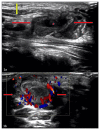Imaging Findings of Ulceroglandular Tularemia
- PMID: 28580063
- PMCID: PMC5443626
- DOI: 10.3941/jrcr.v11i1.2983
Imaging Findings of Ulceroglandular Tularemia
Abstract
Francisella tularensis, the causative organism in Tularemia, is a relatively rare disease. There are a few radiological clues to elucidate its presence when suspicion arises. There should be strong consideration for Tularemia in the differential of any patient with its classic symptoms, diffuse cervical lymphadenopathy with evidence of necrosis, and enlarged adenoids. Ultrasound may demonstrate suppurative lymphadenopathy suggestive of infection, as in the case presented. CT often will demonstrate the extent of lymphadenopathy. On chest radiography, tularemia pneumonia is often the presenting finding, which may demonstrate bilateral or lobar infiltrates. Additionally, hilar lymphadenopathy and pleural effusions are often associated findings. Cavitary lesions may be present, which are better delineated on CT scan. We present a case of a 7-year-old male who presented with a painful right-sided palpable neck mass for 9 days, who was diagnosed with Tularemia after numerous admissions.
Keywords: Computer Tomography; Francisella; Lymphadenopathy; Rabbits; Suppurative; Tularemia; Tularensis; Ulceroglandular; Ultrasound.
Figures



Similar articles
-
Ultrasound and ultrasound shear-wave elastography evaluation of ulceroglandular type of tularemia.J Clin Ultrasound. 2024 Oct;52(8):1183-1187. doi: 10.1002/jcu.23745. Epub 2024 Jun 17. J Clin Ultrasound. 2024. PMID: 38887811
-
[Prolonged course of tick-borne ulceroglandular tularemia in a 20-year-old patient in Germany--case report and review of the literature].Dtsch Med Wochenschr. 2009 Jul;134(27):1405-10. doi: 10.1055/s-0029-1225296. Epub 2009 Jun 23. Dtsch Med Wochenschr. 2009. PMID: 19551605 Review. German.
-
Ulceroglandular tularemia complicated by pneumonia--a case report.Przegl Epidemiol. 2014;68(3):421-4, 531-4. Przegl Epidemiol. 2014. PMID: 25391005 English, Polish.
-
Suppurative cervical adenopathy and pharyngeal mass due to tularemia unresponsive to medical treatment.Turk J Pediatr. 2011 Sep-Oct;53(5):554-7. Turk J Pediatr. 2011. PMID: 22272458
-
Tularemia pneumonia.Semin Respir Infect. 1997 Mar;12(1):61-7. Semin Respir Infect. 1997. PMID: 9097380 Review.
Cited by
-
Vector-Borne Tularemia: A Re-Emerging Cause of Cervical Lymphadenopathy.Trop Med Infect Dis. 2022 Aug 16;7(8):189. doi: 10.3390/tropicalmed7080189. Trop Med Infect Dis. 2022. PMID: 36006281 Free PMC article. Review.
References
-
- Baggett M, Gonzalez G, Bhattacharyya R, et al. Case 4-2016. New England Journal of Medicine. 2016;374(6):573–581. - PubMed
-
- Treat J, Hess S, McGowan K, Yan A, Kovarik C. Ulceroglandular Tularemia. Pediatric Dermatology. 2010;28(3):318–320. - PubMed
-
- Umlas S, Jaramillo D. Massive adenopathy in oropharyngeal tularemia; C. T. demonstration. Pediatric Radiology. 1990;20(6):483–484. - PubMed
Publication types
MeSH terms
Substances
LinkOut - more resources
Full Text Sources
Other Literature Sources
Medical

